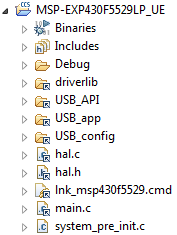SLAU533D September 2013 – April 2017
-
MSP430F5529 LaunchPad™ Development Kit (MSP‑EXP430F5529LP)
- Trademarks
- 1 Getting Started
- 2
Hardware
- 2.1 Block Diagram
- 2.2
Hardware Features
- 2.2.1 MSP430F5529
- 2.2.2 eZ-FET lite Onboard Emulator
- 2.2.3 Integrated Full-Speed USB Hub
- 2.2.4 Power
- 2.2.5 Clocking
- 2.2.6 Application (or "Backchannel") UART
- 2.2.7 Emulator and Target Isolation Jumper Block
- 2.2.8 Isolation Jumper Block: 3.3-V and 5-V Jumpers
- 2.2.9 Isolation Jumper Block: Emulator Connection and Application UART
- 2.3 Measure Current Draw of MSP430 MCU
- 2.4 Using an External Power Source
- 2.5 Using the eZ-FET lite Emulator With a Different Target
- 2.6 USB BSL Button
- 2.7 BoosterPack Plug-in Module Pinout
- 2.8 Design Files
- 2.9 Hardware Change Log
- 3
Software Examples
- 3.1 MSP430 Software Libraries: driverlib and the USB API
- 3.2 Viewing the Code
- 3.3 Example Project Software Organization
- 3.4 USB Configuration Files
- 3.5 Out-of-Box Experience: emulStorageKeyboard
- 3.6 Example: simpleUsbBackchannel
- 3.7 Starting Device Manager
- 4 Additional Resources
- 5 FAQs
- 6 Schematics
- Revision History
3.3 Example Project Software Organization
The simpleUsbBackchannel example and the emulStorageKeyboard example share a similar project organization. Figure 26 shows the CCS version of emulStorageKeyboard, and Table 6 describes the functions of these files and directories.
 Figure 26. F5529 LaunchPad Development Kit Demo Software Organization
Figure 26. F5529 LaunchPad Development Kit Demo Software Organization Table 6. Demo Project File and Directory Descriptions
| Name | Description |
|---|---|
| main.c | The main() function |
| hal.c, hal.h | Hardware abstraction layer for the MSP430F5529 LaunchPad development kit |
| driverlib | MSP430 foundational software library, for accessing core MSP430 functions and peripherals. The USB API and examples use it to manage clocks, power, and the DMA module. driverlib is part of MSP430Ware. |
| USB_API | The MSP430 USB API, part of the MSP430 USB Developers Package. |
| USB_config | Contains three files that configure the USB API for the application needs. In particular, they define the USB interfaces that are used for the respective demo application. These files were generated by the USB Descriptor Tool, located in the MSP430 USB Developers Package. |
| USB_app | Files related to USB functionality, but which are part of the application and not the USB API itself. These files handle the keyboard emulation, and implement the virtual storage volume mounted by the device. The directory also contains the USB "event handlers". |